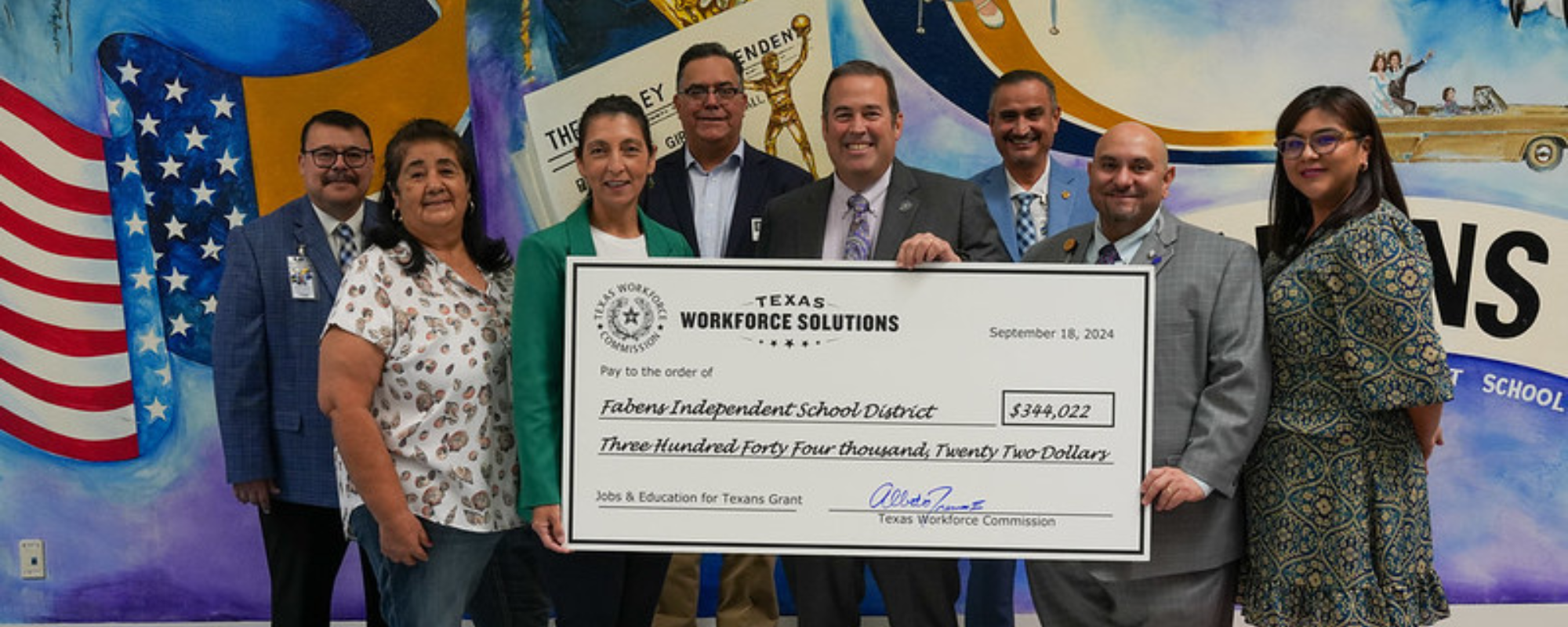Public Education’s Crucial Role in Workforce Development
Texas boasts a strong and diverse economy. In fact, it is the eighth largest economy in the world with a gross domestic product of some $2.4 trillion. Companies are eager to expand their operations or relocate to the state. But as the economy grows, so do Texas’ employment needs, making workforce development a critical focus for state leaders.
Texas public school leaders are working hard to help address that need. As students in public schools complete coherent sequences of career and technical education courses and earn industry-based certifications, districts are building robust career development programs. The need for practicum experiences, hands-on equipment, and guidance on industry demands are driving forces in career classroom experiences.
Through grant programs, the Texas Workforce Commission has been able to serve as a support partner in this process. Whether located in rural or population-dense districts, TWC collaborates with 28 regional workforce development offices to identify the needs of the labor market. Alberto Treviño III has served as TWC commissioner representing labor since January 2023. His office is working to enhance strategic partnerships and innovative school programs across the state.
Texas Lone Star talked to Treviño about TWC’s workforce development efforts in public schools. His comments are condensed and lightly edited.
Q: Can You Tell Us About Your Role and Responsibilities as the Commissioner Representing Labor for TWC?
My role is to represent the more than 14 million working Texans. I work to ensure they’re treated fairly and respected in the workplace. I also work to ensure that Texas workers have access to career development training and good-paying jobs across the state.
Q: What Inspired You to Apply for this Role?
My whole career was in law enforcement, and when I retired, I transitioned to teaching law enforcement classes at Texas Southmost College in Brownsville. I found out the commissioner position was available, and I was encouraged to apply. I was eager to do so because it would be another chance to serve my fellow Texans in a different capacity. I applied, got hired, and then, still in a way, represent my community back home in the Rio Grande Valley.
Q: How Does Your Office Collaborate with Public Schools to Support Workforce Development Initiatives?
I meet regularly with our 28 Texas workforce development boards and workforce solution offices across the state. They’re the ones who know their communities very well. They understand the pulse of the local ecosystems in those areas and have strong relationships with the local public schools.
Q: Why do You Believe Allocating Funds to Enhance Workforce Development Programs in School Districts is Important?
It’s important because many school districts don’t have the financial backing they need to keep up with some of the high-demand occupations and some of the in-demand trade industries. Grants assist them [districts] in getting the equipment they need and provide the ability to train the students to compete in today’s job market.
Q: How do Improved Workforce Preparedness Programs Contribute to the State’s Overall Labor Development?
We get to target the in-demand jobs that are in the area or that are coming to Texas. Many industries, not just manufacturing but tech industries, seek to do business here. We need a workforce that can compete to take those jobs, and that’s where programs like the Jobs & Education for Texans (JET) grant comes in. We help prepare the workforce through school programs so that students can get necessary licenses and industry-based certificates, even before graduation. So, when they come out, they’re already one step ahead and can continue their post-secondary education journey, stack on additional certifications, or directly enter the workforce.
Q: What Key Programs or Initiatives has TWC Funded in School Districts, and how do These programs Address the Skill Gaps in the Labor Market?
High-demand occupations are the backbone of the programs supported by this JET grant. We’ve funded a variety of systems, including nursing, welding, HVAC, veterinary sciences, and pharmaceutical technician programs. In West Texas, there is oil and gas; mining and logging in East Texas; and a lot of chip industry in North and Central Texas. There are different needs along the coastal region of Texas as well. Because each region has their own unique high-demand industries and those represented across the state are as diverse as student interests, the JET Grant Program can meet employers and students where they are at by supporting CTE pathways that lead to credentials in high-demand occupations and still represent a diverse inventory of career options for students to train in.
Q: How Much Money was Allotted to School Programs in the 2023-24 School Year, and How Does a School Become Eligible for the JET Grant Program?
The JET grant awarded $15 million to fund 60 career training grants across Texas. We hope to see a similar number in 2025. Public junior, state, or technical colleges; the Windham School District; and public independent school districts and open-enrollment charter schools — in partnership with a public junior, state, or technical college — can apply for the grants, as determined by statute. Our JET Advisory Board, a six-member panel, meets annually to discuss the regional needs across the state and present a recommendation to our agency on evaluation results. Applicants can apply for a minimum of $40,000 or a maximum of $375,000. We encourage all applicants to carefully read through the Request for Applications documents each year to ensure they develop a competitive and viable grant application.
Q: Tell Us About How a Region in Texas Successfully Used a Collection of JET Grant Funds.
A story that stands out is Chapel Hill ISD in North Texas. They were awarded a $210,259 grant to train 119 students as welders, cutters, solderers, and brazers in partnership with Northeast Texas Community College. During that visit, we also awarded five other local rural districts a collective $1.18 million to meet similar apprenticeship needs in the region. Together, this will benefit that region.
Q: How do the 28 Workforce Offices Work with Local Businesses and Industries to Ensure School Programs Align with Workforce Needs?
The 28 workforce boards communicate with the local businesses, with the school districts, and the economic development corporations, keeping them in pace with what the region needs. The boards are at the heart of working in partnership with our local communities.
Q: Do You Have Any New Initiatives or Innovations that You’re Excited About in the Realm of Labor Development in Texas?
An issue that was important to me through all my time in law enforcement, and one I still to get to focus on is working closely with our state’s foster youth. When a child turns 18, they’re out of the foster care system. I can remember myself at 18 and I would not have been mentally prepared to be on my own and be able to sustain that. I want to ensure our foster youth have the career training they need, and the ability to go to postsecondary school and land a good job. That program is underway.
Q: Do You Have Any Messages You’d Like to Convey to Policymakers, Educators, and the Public About the Importance of the JET Grant Funding You All Provide?
The program has been a huge success. Since its start in 2016, the JET program has awarded over $105 million in [state-funded] grants. In 2023, the Texas Workforce Commission awarded 42 grants totaling more than $11 million to purchase equipment and initially train over 8,000 students in high-demand occupations.
Q: Would You Like to Share Anything Else with Our Readers About the Work Your Office is Doing to Support the Future Workforce of Texas?
TWC and our 28 workforce solution boards continue to build our Texas labor force by removing barriers. We focus on highly specialized training that will prepare the workforce for the future, and we continue to upskill Texans to create that pipeline of in-demand workers to meet the needs of employers and regional employment ecosystems across the state, and that keeps Texas the best place to live and work.
The Jobs & Education for Texans Grant is a competitive grant process and is now accepting applications for the 2025 JET grant program. Texas public junior, state, and technical colleges; school districts; and open-enrollment charter schools may apply. Information about the application can be found online at twc.texas.gov/programs/jet. To be added to the JET grant email distribution list to receive future announcements, email jetgrants@twc.texas.gov with a request and your contact information.

Brianna Garcia
Brianna Vela Garcia joined the Communications, Marketing, and Events team in 2024 as a department director. She assists with TASB's communication efforts and other related projects. Before TASB, Garcia spent eight years working in public education communications. Most recently, she was the media and public relations director for a Texas public school district.
Garcia holds a bachelor's degree in mass communications from the University of Texas-Pan American and a master's in journalism from the University of North Texas.





